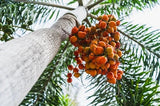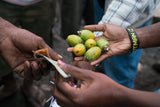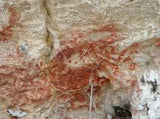BETEL HABIT PARAPHERNALIA: UNIQUE RARE OLDER POLYCHROME COASTAL RAMU RIVER BETEL MORTAR, HAND CARVED, UNUSUAL CANOE SHAPED WITH BASE, COLOR PIGMENTS, NICE PATINA, COLLECTED IN THE FIELD, NEW GUINEA, MID 20TH CENTURY. 8” LONG
Unique Rare, Old, Hand Carved Ramu Betel Mortar, from Huon Gulf Tribe, Important Tool used during the betel lime habit (quid) by elders, Papua New Guinea.
(seen on most of the photos that are not taken in the field). ITEM 1 FROM OUR PRIVATE COLLECTION.
8 1/4" x 2 1/2" x 3".
20 1/2 cms x 6 cms x 7 1/2"
This piece was entirely hand carved out of local wood in the mid 20th century, in the shape of a canoe, and is in great shape, with the natural pigments colors still apparent on the body, red ocre and some tiny remnants of white lime powder seen in the grooves, hand etched with wave motifs. We stored it safely for many years.
Betel pounders or mortars are used by toothless people for mashing up the ingredients of the quid in Papua New Guinea.
Some photos show lime & betel nuts sold in a market of Papua New Guinea and people traditionally chewing betel nut dipped in lime, which causes teeth and gums to become red and later gums and teeth to turn black and rot away.
The Betel nuts, also called Pugua or Mama'on, are 'palm nuts' from the areca palm tree. The scientific name for the tree is 'Areca catechu' and resembles a thin coconut palm tree. These hard nuts are chewed casually like chewing gum by islanders and is a permanent feature of the cultures of the Pacific. Nut chewing is definitely an acquired habit more commonly passed down from grandparents (called guelo) to grandchildren.
Three substances are actually chewed together: the nut of a palm, which has a hot, acrid taste similar to nutmeg; the leaf, bean, or stem of the betel vine, which is a member of the pepper family; and slaked lime made from burned sea shells or coral or from mountain lime and kept in this container while not in use. Once chewed, the mixture becomes a mild stimulant said to reduce hunger, pain, create a sense of well-being, and increase a person's capacity for work. Chewing betel nut makes people teeth turn red and eventually rot.
All our collector and rare items come with pages and pages of research about provenance, and with history of the tribes and photos as well, depending on item and whenever possible. When shipping internationally, we group ship multiple purchases to save you money, and find the best rates available. If you have any questions or want to see research conducted on this piece and photos of tribes, let us know.



























































